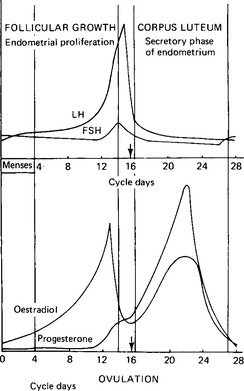The menstrual cycle, pregnancy and lactation
Publisher Summary
This chapter describes the process of menstrual cycle, pregnancy and other related anatomical and physiological processes, and lactation. The human female experiences from menarche to menopause a cyclical variation in hormone levels, in the state of the generative organs, and in the release of ova. The cycle has a rhythm of approximately 28 days, a lunar month, and is, therefore, termed menstrual. The hypothalamus controls the cycle by stimulating a cyclical release of the gonadotropin hormones, follicle stimulating hormone (FSH) and luteinizing hormone (LH). If fertilization occurs and the fertilized ovum is implanted into the uterine wall, then the corpus luteum, instead of involuting, continues to produce both estrogen and progesterone. By the end of the first week after fertilization, the tissue supporting the embryo, the placenta, produces chorionic (placental) gonadotropin— human chorionic gonadotrophin. A peptide hormone, relaxin, is produced in the pregnant uterus up to the time of birth: it permits widening of the pubic symphysis and therefore the pelvic opening, facilitating the actual process of birth. Even after childbirth, the mother would still show hormonal changes. The baby would continue to need nutriment, and this is supplied by the mother until the infant is weaned. The mammary glands develop under the influence of chorionic estrogen and progesterone, but together these hormones inhibit milk secretion.
The menstrual cycle
The human female experiences from menarche to menopause a cyclical variation in hormone levels, in the state of the generative organs, and in the release of ova (Fig. 22.1). The cycle has a rhythm of approximately 28 days, a lunar month, and is therefore termed ‘menstrual’. It varies from 21 to 40 days, but is usually fairly constant for any one individual. The cycle is normally only interrupted by pregnancy and lactation – although it may be replaced by a pharmacological cycle in which ovulation is inhibited. The normal sequence of events occurring as a result of the hormonal changes begins with a proliferation of the epithelial lining of the wall of the uterus and the underlying endometrium. Associated with these changes is a thickening of the epithelial lining of the vagina and a cornification of its surface layers. The uterine muscle also increases in thickness. This preovulatory part of the cycle is therefore called the proliferative phase. The uterine changes represent a preparation for the implantation of the fertilised ovum. The ovum is released at approximately mid-cycle (12–21 days), and travels down the fallopian tube to the uterus. After ovulation the endometrium enters a secretory phase, during which the glands become coiled and secrete more actively, while the endometrium as a whole becomes oedematous. Should fertilisation not occur, the endometrium degenerates and sloughs off, and the cells, secretions and blood from the raw surface are lost in the discharge of menstruation.
Stay updated, free dental videos. Join our Telegram channel

VIDEdental - Online dental courses



